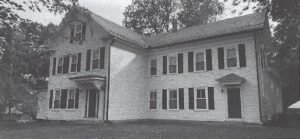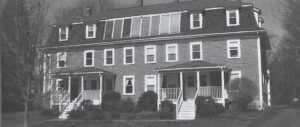Apr 1, 2024
Editor’s note: This story is excerpted from Richard DeSorgher’s “This Old Town: On the Banks of the Charles” (to order book see bottom of page)
From 1868 when Oliver and Elizabeth Clifford moved their family to Medfield until the death of their daughter Ellen in 1919, the Clifford name was a well-known and important piece of the fabric of Medfield. They acquired substantial wealth and built homes and multi-unit rental houses throughout the town.
Oliver Hamblin Clifford was born in 1809 in Brookfield, Vermont. He came to Medfield as a young man and in 1835 married Elizabeth Mason, a descendant of Medfield’s second minister, Rev. Joseph Baxter and of Thomas Mason, one of Medfield’s original 13 settlers. After marriage, they settled in East Medway (now Millis) where Oliver started a farm and carried on a productive meat market business. In Medway, Oliver and Elizabeth gave birth to their four children, Joseph Clark, born in 1839, Alfred, born in 1845, Ellen, born in 1845 and Elizabeth, born in 1854.
In 1868, Oliver and Elizabeth moved to Medfield. Here, Oliver became a developer and an investor. He served as a selectman in 1871, 1872 and in 1882. He built the first house on the newly laid out Spring Street in 1872, now #5-7 Spring Street.

Credit: Fritz Clifford
The Greek Revival-style house with brick foundation was built for him and here he lived with his family. (In 1988, the Spring Street house was converted into four townhouse condominiums. The Medfield Zoning Board of Appeals approved the variance stipulating that the developer work with the Medfield Historical Commission in preserving the exterior of the house. Because of that cooperation, the Medfield historical Commission awarded the developer, William Nutile, its annual Preservation Award for his effort in preserving the house’s history while turning it into condominiums, showing that such historic structures do not have to be torn down but can be saved and preserved while still economically viable to the developer.)

Credit: Medfield Historical Society
Oliver then had built the Clifford Block on #8-14 Green Street, two multi-unit houses on Adams Street, #24 and #26-28, and a multi-unit block on #58-60 Harding Street (now demolished). These multi-unit houses filled the need for rental property for the seasonal workers in the prosperous hat factory on North Street (now Montrose School).

Credit: Medfield Historical Society
Son, Joseph, attended Thetford Academy in Vermont and graduated from Amherst College with the Class of 1862. Shortly after graduation, he married Mary Condit from New Hampshire. After the wedding ceremony, with the Civil War now in its second year, he enlisted into Company B, Massachusetts 42 Infantry and quickly was promoted to 2nd Lieutenant. He mustered out of the service in August of 1863 and for a short time taught school back in New Hampshire. Less than a year later he re-enlisted into the service, receiving his commission as an officer in Company E, 1st New Hampshire Heavy Artillery Regiment. By the end of the war, he had been promoted again, this time to a full 2nd Lieutenant. He was on duty at the White House after the assassination of President Abraham Lincoln and was one of the soldiers used as an escort of Lincoln’s body during the funeral. Joseph stayed in the military following the war and became a career officer. He died on November 12, 1890, and was buried in Arlington National Cemetery in Virginia, overlooking Washington D.C.
Second son, Alfred, moved to St. Louis where he and his partner John Gates, through shrewd business tactics, became wealthy Gilded Age industrialists. Here Clifford and Gates purchased a machine made by George C. Baker for producing barbed wire which was similar but not identical to one made by Isaac Ellwood and used by the Ellwood and Washburn-Moen Company. Gates and Clifford and their company, Southern Wire Company, sold their product at a cheaper price than Washburn-Moen. Before long, Washburn-Moen was losing substantial business to Gates and Clifford’s Southern Wire Company.
In an effort to stop the success of Gates and Clifford, Ellwood and Washburn-Moen filed for an injunction to stop the business of Southern Wire Company. The suit, filed in U.S. District Court, claimed the machines Gates and Clifford used in the production of their product were a direct copy of those used by Washburn-Moen. The suit also called for Gates and Clifford to pay $100,000 in damages to the company. Fearful of the court’s possible decision, Gates and Clifford were able to rent a building in East St. Louis, Illinois and moved their equipment out the factory and onto a ferryboat after dark. After they crossed the Mississippi River, the machines were out of the jurisdiction of the St. Louis, Missouri U.S. District Court and they were back in business the next day, this time in Illinois.
Through a series of mergers and acquisitions the company went through various name changes, finally settling on American Steel and Wire Company. In 1901 J. P. Morgan’s U.S. Steel bought them out. Clifford became director of the U.S. Steel Corporation and lived the life of a wealthy industrialist. Alfred died in St. Louis, Missouri on November 26, 1927.
The Clifford’s third child, Ellen, was 22 years old when her family moved from East Medway back to Medfield. Ellen was hired as a teacher in the Hannah Adams School (South School), where she taught for several years. In 1881, under Massachusetts law, women were permitted to vote for school committee for the first time. Seven Medfield women registered to vote, including Ellen Clifford. In 1884 she ran for the office of school committee and became the first woman in Medfield to be elected to public office. She served on the school committee until 1886 and held the position of recording secretary. During her term of office, she worked hard for the passage of the Free Textbook Law, which was ratified by the Massachusetts legislature in 1885, stating that cities and towns must provide books and supplies to students attending public schools. Ellen took over managing the family’s lucrative rental tenement properties after the death of her parents. Ellen never married and died of cancer on October 17, 1919, at the age of 73. She is buried in the Clifford family lot in Vine Lake Cemetery.
The fourth of the Clifford children, Elizabeth, married George Mitchell of Medfield in 1878. It would be their son, Harold, who would later inherit Ellen’s estate. Just five years after their marriage, Elizabeth died of convulsions in 1883 at the age of 29.
Oliver died on June 8, 1893 and his wife Elizabeth on November 17, 1901. Both are buried in the Clifford family lot in Vine Lake Cemetery.

Credit: Medfield Historical Society
The cost to purchase a book is $20, which includes tax plus $4 shipping (total $24). Books may be ordered by Venmo: @Julie-DeSorgher (last four digits of phone are 7877 if needed) or by mailing a $24 check to: This Old Town, 65 Shields Road, Mashpee, MA 02649. Check should be made out to This Old Town and include a return address and state the name(s) of who if anyone they want Richard to sign it to.